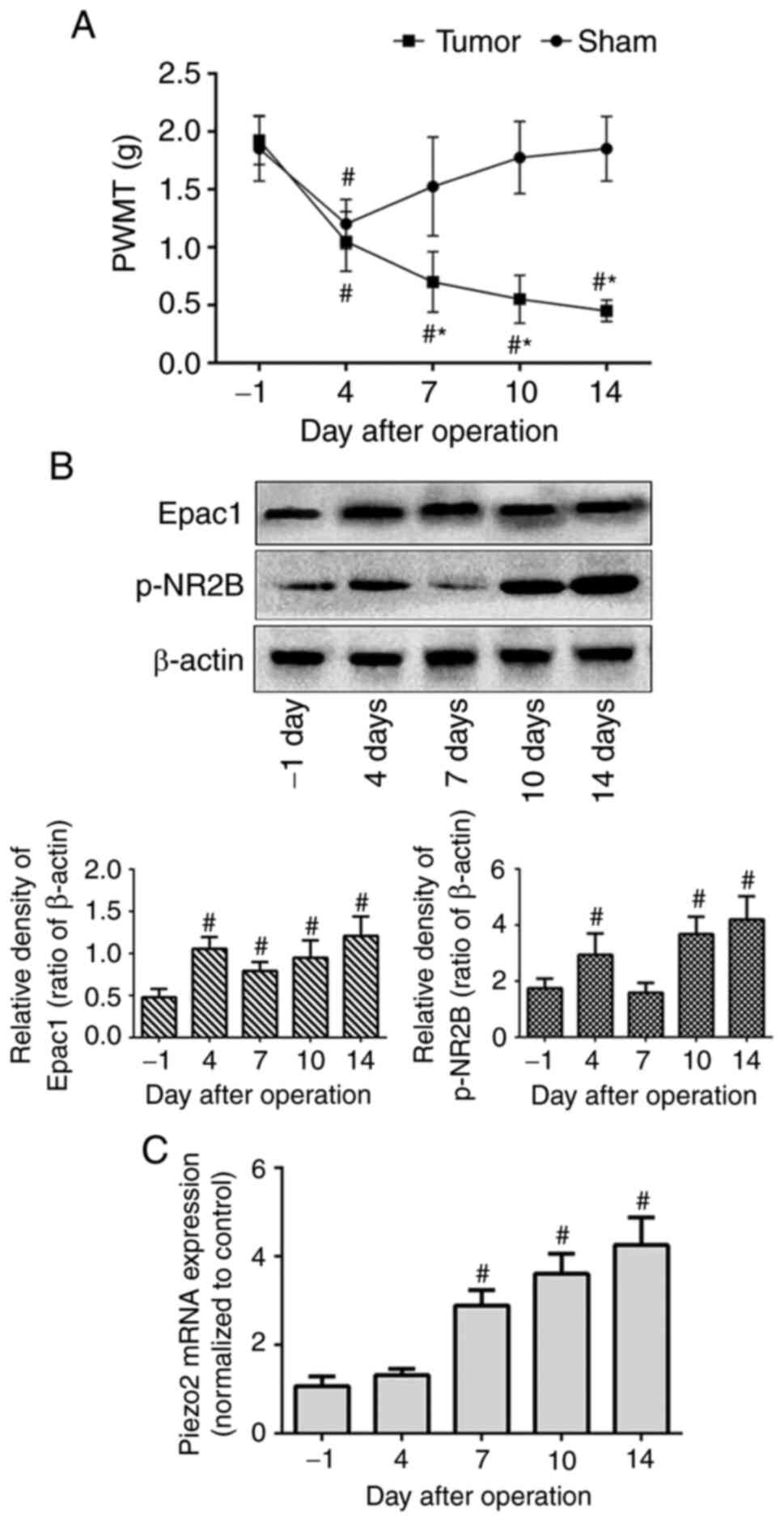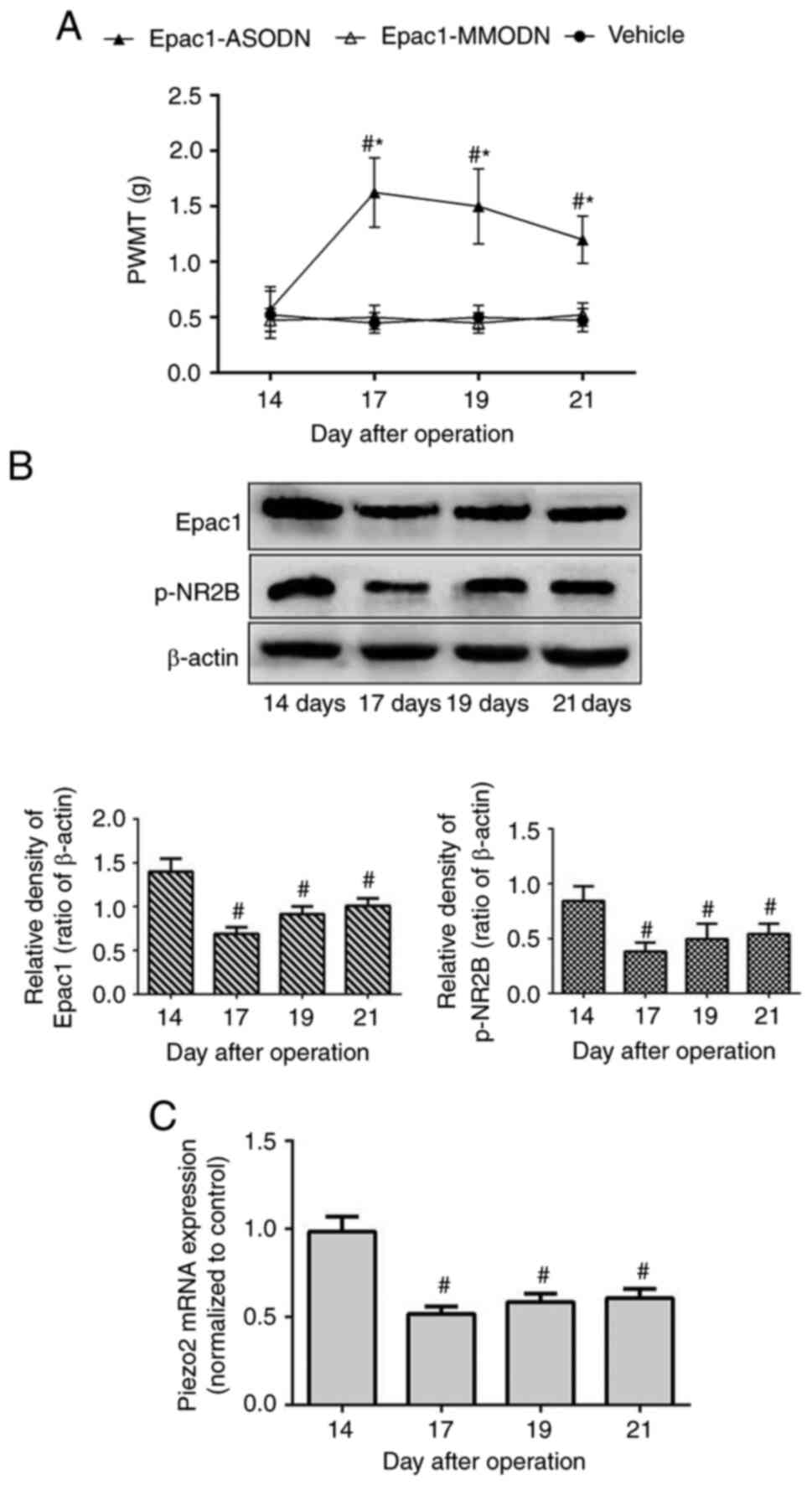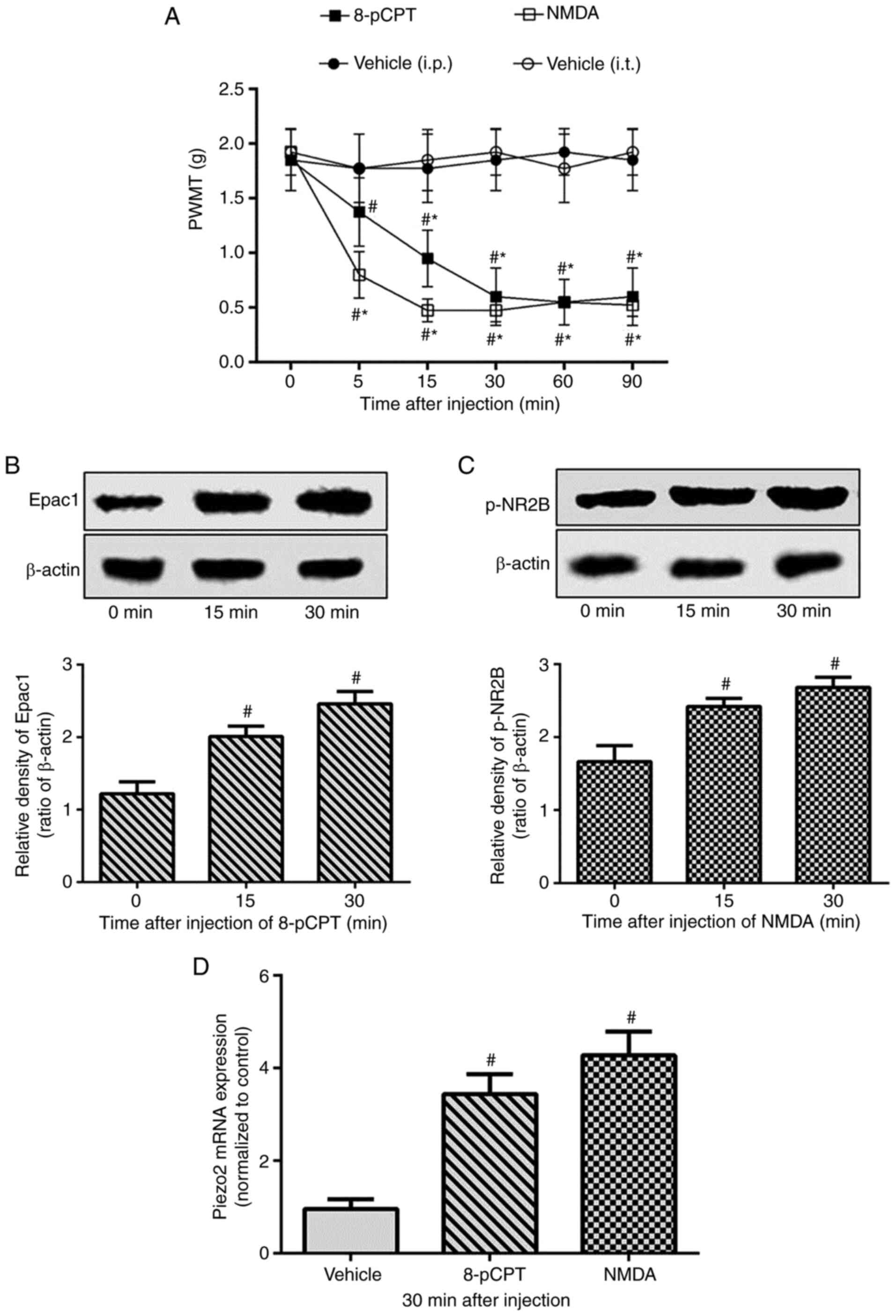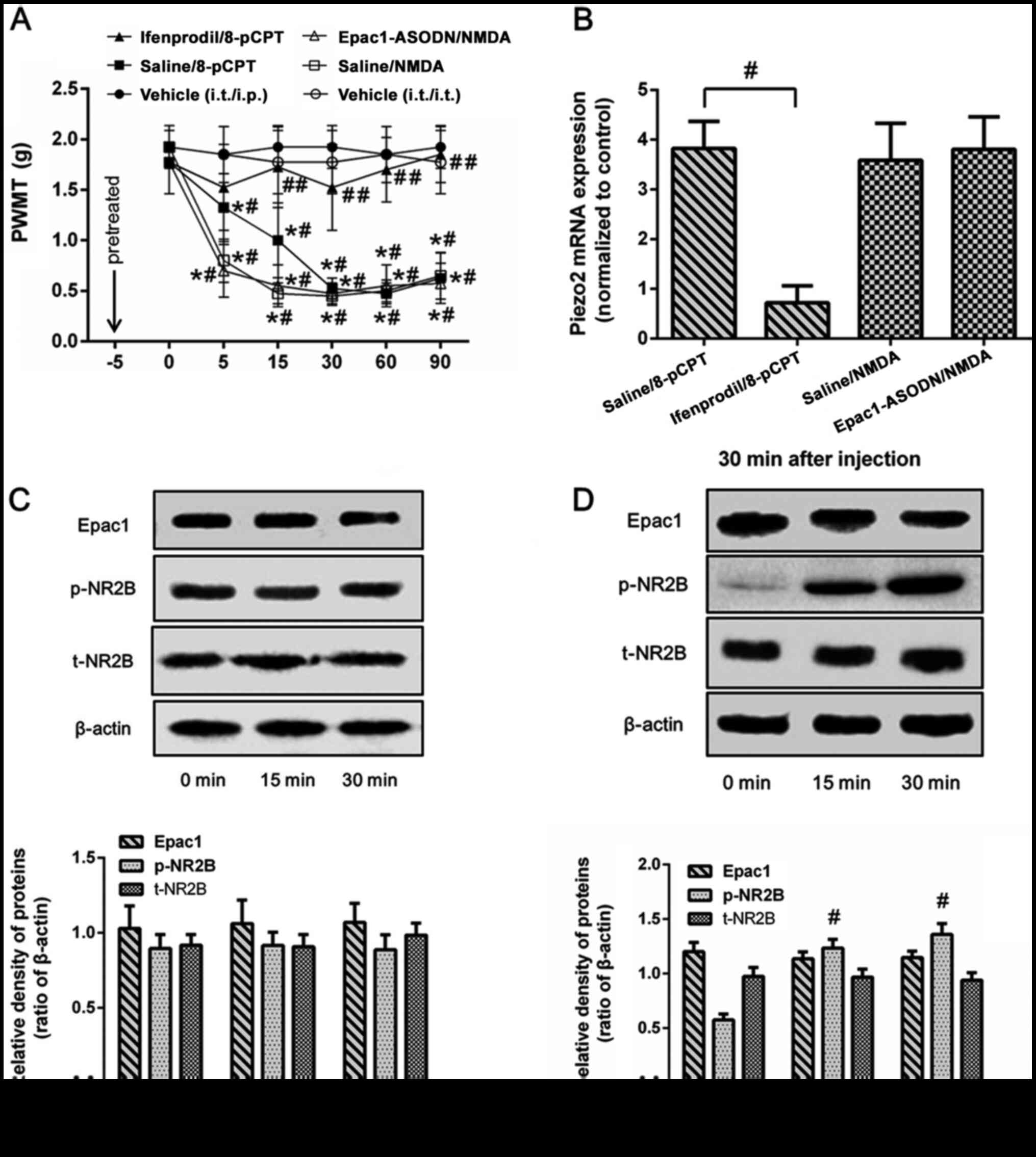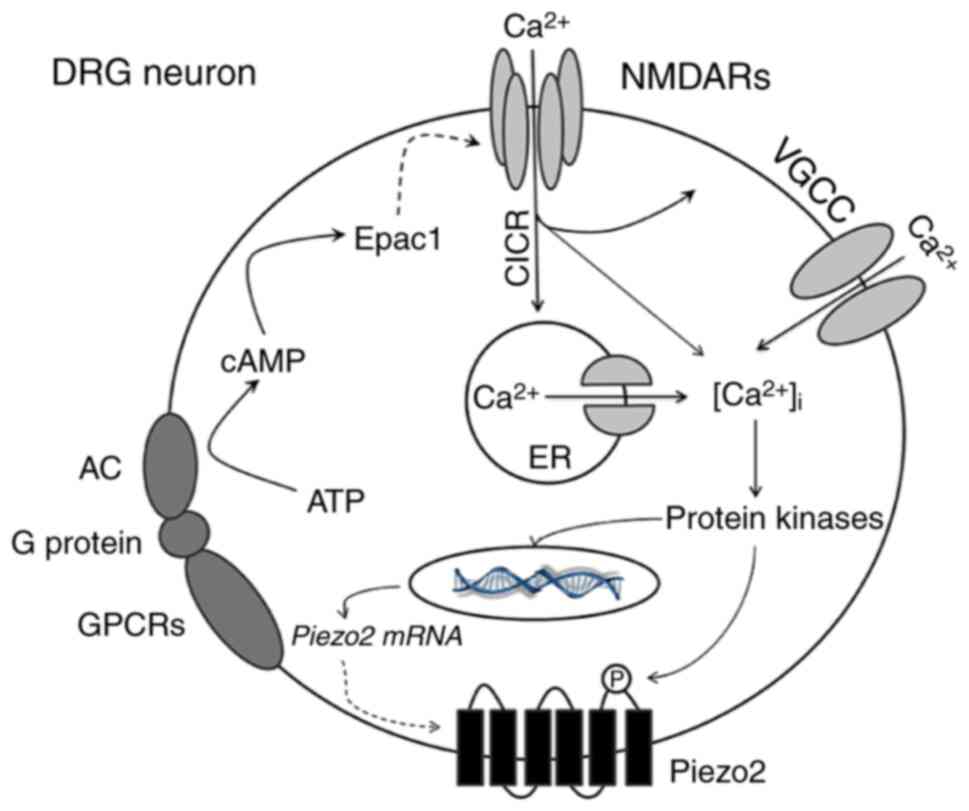|
1
|
Mantyh P: Bone cancer pain: Causes,
consequences, and therapeutic opportunities. Pain. 154 (Suppl
1):S54–S62. 2013. View Article : Google Scholar : PubMed/NCBI
|
|
2
|
Scarborough BM and Smith CB: Optimal pain
management for patients with cancer in the modern era. CA Cancer J
Clin. 68:182–196. 2018. View Article : Google Scholar : PubMed/NCBI
|
|
3
|
Colvin L and Fallon M: Challenges in
cancer pain management-bone pain. Eur J Cancer. 44:1083–1090. 2008.
View Article : Google Scholar : PubMed/NCBI
|
|
4
|
Coste B, Mathur J, Schmidt M, Earley TJ,
Ranade S, Petrus MJ, Dubin AE and Patapoutian A: Piezo1 and Piezo2
are essential components of distinct mechanically activated cation
channels. Science. 330:55–60. 2010. View Article : Google Scholar : PubMed/NCBI
|
|
5
|
Ranade SS, Woo SH, Dubin AE, Moshourab RA,
Wetzel C, Petrus M, Mathur J, Bégay V, Coste B, Mainquist J, et al:
Piezo2 is the major transducer of mechanical forces for touch
sensation in mice. Nature. 516:121–125. 2014. View Article : Google Scholar : PubMed/NCBI
|
|
6
|
Murthy SE, Loud MC, Daou I, Marshall KL,
Schwaller F, Kühnemund J, Francisco AG, Keenan WT, Dubin AE, Lewin
GR and Patapoutian A: The mechanosensitive ion channel Piezo2
mediates sensitivity to mechanical pain in mice. Sci Transl Med.
10:eaat98972018. View Article : Google Scholar : PubMed/NCBI
|
|
7
|
Szczot M, Liljencrantz J, Ghitani N, Barik
A, Lam R, Thompson JH, Bharucha-Goebel D, Saade D, Necaise A,
Donkervoort S, et al: PIEZO2 mediates injury-induced tactile pain
in mice and humans. Sci Transl Med. 10:eaat98922018. View Article : Google Scholar : PubMed/NCBI
|
|
8
|
Berkey SC, Herrera JJ, Odem MA, Rahman S,
Cheruvu SS, Cheng X, Walters ET, Dessauer CW and Bavencoffe AG:
EPAC1 and EPAC2 promote nociceptor hyperactivity associated with
chronic pain after spinal cord injury. Neurobiol Pain.
7:1000402019. View Article : Google Scholar : PubMed/NCBI
|
|
9
|
Huang LY and Gu Y: Epac and nociceptor
sensitization. Mol Pain. 13:17448069177162342017. View Article : Google Scholar : PubMed/NCBI
|
|
10
|
Li ZH, Cui D, Qiu CJ and Song XJ: Cyclic
nucleotide signaling in sensory neuron hyperexcitability and
chronic pain after nerve injury. Neurobiol Pain. 6:1000282019.
View Article : Google Scholar : PubMed/NCBI
|
|
11
|
Hucho TB, Dina OA and Levine JD: Epac
mediates a cAMP-to-PKC signaling in inflammatory pain: An isolectin
B4(+) neuron-specific mechanism. J Neurosci. 25:6119–6126. 2005.
View Article : Google Scholar : PubMed/NCBI
|
|
12
|
Eijkelkamp N, Linley JE, Torres JM, Bee L,
Dickenson AH, Gringhuis M, Minett MS, Hong GS, Lee E, Oh U, et al:
A role for Piezo2 in EPAC1-dependent mechanical allodynia. Nat
Commun. 4:16822013. View Article : Google Scholar : PubMed/NCBI
|
|
13
|
Zimmermann M: Ethical guidelines for
investigations of experimental pain in conscious animals. Pain.
16:109–110. 1983. View Article : Google Scholar : PubMed/NCBI
|
|
14
|
Ni K, Zhou Y, Sun YE, Liu Y, Gu XP and Ma
ZL: Intrathecal injection of selected peptide Myr-RC-13 attenuates
bone cancer pain by inhibiting KIF17 and NR2B expression. Pharmacol
Biochem Behav. 122:228–233. 2014. View Article : Google Scholar : PubMed/NCBI
|
|
15
|
Schwei MJ, Honore P, Rogers SD,
Salak-Johnson JL, Finke MP, Ramnaraine ML, Clohisy DR and Mantyh
PW: Neurochemical and cellular reorganization of the spinal cord in
a murine model of bone cancer pain. J Neurosci. 19:10886–10897.
1999. View Article : Google Scholar : PubMed/NCBI
|
|
16
|
Chen G, Xie RG, Gao YJ, Xu ZZ, Zhao LX,
Bang S, Berta T, Park CK, Lay M, Chen W and Ji RR: β-arrestin-2
regulates NMDA receptor function in spinal lamina II neurons and
duration of persistent pain. Nat Commun. 7:125312016. View Article : Google Scholar : PubMed/NCBI
|
|
17
|
Xiaoping G, Xiaofang Z, Yaguo Z, Juan Z,
Junhua W and Zhengliang M: Involvement of the spinal NMDA
receptor/PKCγ signaling pathway in the development of bone cancer
pain. Brain Res. 1335:83–90. 2010. View Article : Google Scholar : PubMed/NCBI
|
|
18
|
Chaplan SR, Bach FW, Pogrel JW, Chung JM
and Yaksh TL: Quantitative assessment of tactile allodynia in the
rat paw. J Neurosci Methods. 53:55–63. 1994. View Article : Google Scholar : PubMed/NCBI
|
|
19
|
Livak KJ and Schmittgen TD: Analysis of
relative gene expression data using real-time quantitative PCR and
the 2(-Delta Delta C(T)) method. Methods. 25:402–408. 2001.
View Article : Google Scholar : PubMed/NCBI
|
|
20
|
Luger NM, Mach DB, Sevcik MA and Mantyh
PW: Bone cancer pain: From model to mechanism to therapy. J Pain
Symptom Manage. 29 (5 Suppl):S32–S46. 2005. View Article : Google Scholar : PubMed/NCBI
|
|
21
|
Goblirsch MJ, Zwolak PP and Clohisy DR:
Biology of bone cancer pain. Clin Cancer Res. 12:6231s–6235s. 2006.
View Article : Google Scholar : PubMed/NCBI
|
|
22
|
Krames ES: The role of the dorsal root
ganglion in the development of neuropathic pain. Pain Med.
15:1669–1685. 2014. View Article : Google Scholar : PubMed/NCBI
|
|
23
|
Hucho T and Levine JD: Signaling pathways
in sensitization: Toward a nociceptor cell biology. Neuron.
55:365–376. 2007. View Article : Google Scholar : PubMed/NCBI
|
|
24
|
Bos JL: Epac proteins: Multi-purpose cAMP
targets. Trends Biochem Sci. 31:680–686. 2006. View Article : Google Scholar : PubMed/NCBI
|
|
25
|
Bagriantsev SN, Gracheva EO and Gallagher
PG: Piezo proteins: Regulators of mechanosensation and other
cellular processes. J Biol Chem. 289:31673–31681. 2014. View Article : Google Scholar : PubMed/NCBI
|
|
26
|
Wang L, Zhou H, Zhang M, Liu W, Deng T,
Zhao Q, Li Y, Lei J, Li X and Xiao B: Structure and mechanogating
of the mammalian tactile channel PIEZO2. Nature. 573:225–229. 2019.
View Article : Google Scholar : PubMed/NCBI
|
|
27
|
Gu X, Zhang J, Ma Z, Wang J, Zhou X, Jin
Y, Xia X, Gao Q and Mei F: The role of N-methyl-D-aspartate
receptor subunit NR2B in spinal cord in cancer pain. Eur J Pain.
14:496–502. 2010. View Article : Google Scholar : PubMed/NCBI
|
|
28
|
Lau CG, Takeuchi K, Rodenas-Ruano A,
Takayasu Y, Murphy J, Bennett MVL and Zukin RS: Regulation of NMDA
receptor Ca2+ signalling and synaptic plasticity. Biochem Soc
Trans. 37:1369–1374. 2009. View Article : Google Scholar : PubMed/NCBI
|
|
29
|
Liu XG and Zhou LJ: Long-term potentiation
at spinal C-fiber synapses: A target for pathological pain. Curr
Pharm Des. 21:895–905. 2015. View Article : Google Scholar : PubMed/NCBI
|
|
30
|
Sánchez-Pérez AM, Llansola M and Felipo V:
Modulation of NMDA receptors by AKT kinase. Neurochem Int.
49:351–358. 2006. View Article : Google Scholar : PubMed/NCBI
|
|
31
|
Gonzalez-Robayna IJ, Falender AE, Ochsner
S, Firestone GL and Richards JS: Follicle-Stimulating hormone (FSH)
stimulates phosphorylation and activation of protein kinase B
(PKB/Akt) and serum and glucocorticoid-lnduced kinase (Sgk):
Evidence for A kinase-independent signaling by FSH in granulosa
cells. Mol Endocrinol. 14:1283–1300. 2000. View Article : Google Scholar : PubMed/NCBI
|
|
32
|
Singhmar P, Huo X, Eijkelkamp N, Berciano
SR, Baameur F, Mei FC, Zhu Y, Cheng X, Hawke D, Mayor F Jr, et al:
Critical role for Epac1 in inflammatory pain controlled by
GRK2-mediated phosphorylation of Epac1. Proc Natl Acad Sci USA.
113:3036–3041. 2016. View Article : Google Scholar : PubMed/NCBI
|
|
33
|
Ren BX, Gu XP, Zheng YG, Liu CL, Wang D,
Sun YE and Ma ZL: Intrathecal injection of metabotropic glutamate
receptor subtype 3 and 5 agonist/antagonist attenuates bone cancer
pain by inhibition of spinal astrocyte activation in a mouse model.
Anesthesiology. 116:122–132. 2012. View Article : Google Scholar : PubMed/NCBI
|
|
34
|
Yang Y, Zhang J, Gao Q, Bo J and Ma Z:
Etanercept attenuates thermal and mechanical hyperalgesia induced
by bone cancer. Exp Ther Med. 13:2565–2569. 2017. View Article : Google Scholar : PubMed/NCBI
|
|
35
|
Sun Y, Jiang M, Hou B, Lu C, Lei Y, Ma Z
and Gu X: Mas-related gene (Mrg) C activation attenuates bone
cancer pain via modulating Gi and NR2B. PLoS One. 11:e01548512016.
View Article : Google Scholar : PubMed/NCBI
|
|
36
|
Mercadante S and Fulfaro F: Management of
painful bone metastases. Curr Opin Oncol. 19:308–314. 2007.
View Article : Google Scholar : PubMed/NCBI
|
|
37
|
Basbaum AI, Bautista DM, Scherrer G and
Julius D: Cellular and molecular mechanisms of pain. Cell.
139:267–284. 2009. View Article : Google Scholar : PubMed/NCBI
|
|
38
|
Li S, Cao J, Yang X, Suo ZW, Shi L, Liu
YN, Yang HB and Hu XD: NR2B phosphorylation at tyrosine 1472 in
spinal dorsal horn contributed to N-methyl-D-aspartate-induced pain
hypersensitivity in mice. J Neurosci Res. 89:1869–1876. 2011.
View Article : Google Scholar : PubMed/NCBI
|
|
39
|
Alvarez-Vega M, Baamonde A, Gutiérrez M,
Hidalgo A and Menéndez L: Intrathecal N-methyl-D-aspartate (NMDA)
induces paradoxical analgesia in the tail-flick test in rats.
Pharmacol Biochem Behav. 65:621–625. 2000. View Article : Google Scholar : PubMed/NCBI
|















